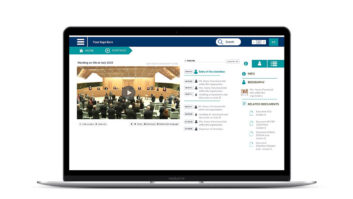
Working at Working Together
Dec 1, 2004 12:00 PM,
By Richard Schrag
Acoustical consulting in today’s collaborative design and construction environment.
Sidebars
Goals for Successful Collaboration
Encouraging Teamwork
Consultants and architects make strange bedfellows sometimes. Outwardly, they acknowledge that if you’re going to build something, it will require teamwork from a variety of people with different areas of expertise. Too often, however, they go about their business as if they were natural adversaries competing for turf, jealously guarding their own interests, and looking for ways to trick the other into ceding the advantage to them.
This presentation theater at NFL Films successfully blends acoustics and architecture, along with a variety of less visible technical systems.
Traditionally, acoustical consultants in particular have had a sort of uneasy alliance with their architectural counterparts. Perhaps that’s because architecture, like acoustics, is part art and part science. The two don’t have to be at odds, however. There can be a healthy interplay between architecture and acoustics, whether in a traditional architect/consultant relationship or in a firm that merges the two. When that happens, it illustrates the relationship between the disciplines, highlights the type of communication that is necessary to successfully complete those types of projects, and shows how acoustical firms can adapt to a changing landscape in facility design and construction.
COMBINING ARCHITECTURE AND ACOUSTICS
Why is the relationship between acoustics and architecture such a complicated one? After all, architects work with consultants (electrical, mechanical, structural, civil, and others) all the time. One reason is that acoustics affects architecture (and is affected by architecture) more directly than other disciplines. Incorporating the HVAC system into a room, for example, is often a matter of finding a way to minimize the aesthetic impact of the necessary components. Success comes when the supply diffusers blend in — when it is not apparent that there are HVAC devices in the room at all. Acoustic treatments, on the other hand, are by their nature more visible. It’s hard to hide something that must cover large surfaces within the room, and the surfaces that determine a room’s sonic character are inevitably the ones that are also easy to see.
In addition, acoustics is not commonly understood as well as other disciplines by persons outside that field. It is still seen as a mysterious and incomprehensible craft, with few objective criteria and implementation that often appears arbitrary. Strangely, this gives some people the sense that they intuitively know acoustics better than other engineering disciplines. Architects, given their role in overall responsibility for project coordination, are sometimes more likely to make decisions about acoustical performance that they wouldn’t touch if it were a traditional engineering issue.
Today’s architectural projects are becoming more collaborative, and they often involve more experts than they would have in the past. Specialization has led to a greater number of roles filled by someone whose contribution addresses a smaller segment of the process. There is an increasing willingness on the part of architects, construction managers, and owners to seek expertise from vendors, consultants with limited scope, or specialists who serve a narrow niche market.
This is driven in part by the recognition that a modest expenditure to seek the counsel of experts can pay off big dividends in the success of that portion of the project. It doesn’t necessarily cost more to do something right; it just requires thinking about it at the right time and incorporating that knowledge early in the process rather than letting certain components of the design be treated as afterthoughts once “more important” decisions have already been made.
WHEN TECHNOLOGY IS IN CONTROL
More players mean that there’s a greater need than ever for all of them to get along, work together, and coordinate their efforts. This is especially true for technically complicated projects, which necessitate a different balance among the typical cast of characters. Performance-driven facilities bring one or more of the technology disciplines (like acoustics, sound reinforcement, or visual presentation) into a role of greater prominence. Many times these projects are initiated with a particular technological goal in mind, and they often grow out of an existing relationship between the client and a firm that has special expertise in that field.
Demanding performance requirements cast a facility project in a different light. If the technology fails, everyone will know it. This tends to differentiate the technology disciplines from architecture and interior design. The aesthetic quality of a built environment is seen as a continuum, while technical performance is subject to “death by fatal flaw” — if it doesn’t work the way it’s supposed to, the facility may be essentially unusable.

At the same time, the entire design and construction process is adopting a more cooperative structure rather than one with clearly defined independent roles, particularly for such technically complex projects. This is seen in trends toward different forms of design/build activities, negotiated contracts, and construction management. Even the tools of design and construction reflect this evolution, with an increasing commonality in the production systems, software, and documentation platforms shared by designers and contractors alike.
Gone are the days when any aspect of the design can be developed and brought to “completion” by one party before getting handed off to the next. Today, the same electronic file is likely to have system after system layered onto it even as each of the previous disciplines continues to develop it. Passing from the architect to a variety of consulting engineers, or from the design team to a variety of contractors and vendors, refinements are likely to be incremental, with less of a “milestone” mentality involved in their transfer from one discipline to the next.
Many processes that traditionally were serial ones are now handled in parallel by multiple parties. For example, requests for information (RFIs) are now distributed simultaneously to everyone who has a stake in the question at hand. Both the tools available for communication among the parties and the increasingly collaborative approach to design and construction mean that the future will tend to be even less hierarchical.

The Mix to Picture room at NFL Films required effective communication among the design disciplines to create a comfortable aesthetic environment with great acoustics.
One noteworthy benefit of this type of teamwork is that it allows alternative solutions to be introduced at a time when they can be effectively implemented. There’s no benefit to having a great idea brought up after all the related decisions have already been made, when it’s too late to build in the infrastructure or too late to complete the associated design efforts. Having all the parties in place and giving them a voice in the team’s decision-making increases the likelihood that the best solutions will find their way to the top.
FINDING THE CENTER
In spite of the diversification of expertise, or perhaps because of it, owners frequently seek out some party in which they can centralize their trust and focus responsibility, whether in the form of project management firms, owner representatives, or construction management models. A “one-stop shopping” approach, however, sometimes finds itself at odds with the specialized nature of projects that are performance-driven or highly technical. If the centralized authority doesn’t listen well to the rest of the team and assimilate diverse details into informed decisions, expert advice may never get full consideration.
One solution to this dilemma is to offer more comprehensive services for specialized project types. When multiple disciplines are closely intertwined it is more difficult to let individual parties work independently to solve the problem, and it becomes more beneficial to have that design responsibility reside in one entity. Blending architecture with acoustical engineering together under one roof can certainly be a distinct benefit to clients. Offering comprehensive project-related design, coordination, and oversight for multiple disciplines not only helps a firm differentiate itself from competitors, but also elevates the cohesion of the overall project design.
When architects and acousticians are on the same team, the conventional working relationship gives way to a different kind of dynamic. The two sides learn a kind a shorthand communication — a common vocabulary of design features, construction components, and successful concepts. Over time, they come to understand the constraints that affect the other’s work, which streamlines the process of finding mutually advantageous solutions to every design challenge.
Integrating different kinds of individuals into a single culture prompts creative cross-pollination, compelling both sides to master a beneficial learning curve. Bringing someone new up to speed with a specialized project type and its specific requirements helps more experienced staff to reconfirm the validity of their assumptions and design parameters. At the same time, it encourages each person to advocate for their own vision and how it might be successfully applied in new ways to solve the problems that the two disciplines share.
THE REST OF THE TEAM
Although it doesn’t always make sense to bring different design capabilities inhouse, another strategy is to endeavor to increase familiarity with other disciplines. A wider knowledge of the work in other areas enables you to better converse with experts in those fields, to work through some of the compromises and possible solutions internally, and to be able to suggest alternate approaches. Of course, seeing things from the other side of the fence also brings an increased awareness of the impact that your own field and specialized technical requirements have on those other systems.
While it is natural to focus on understanding one’s own business, in this type of project environment it is also essential to understand the business of your teammates and become effective communicators about the issues that affect the rest of the design and construction team.
So what are the keys to working successfully as part of a team that includes acoustical specialists and other technology experts?
Communicate
Relationships with the rest of the design and construction team are most successful when based on effective communication of sound design and construction principles. Although it’s important to avoid flawed design and outright mistakes, the number one cause of professional liability claims among design professionals is a breakdown in communication. Communication is at the heart of most problems on a project and must be the focus of attention.
Be a Team Player
Self interests shouldn’t displace project goals or other players’ interests. When your scope on a project is limited, it is easy to become myopic. Stubbornly defending your narrow concerns without regard to the impact on other trades is rarely the path to the best solution.
The risk of collaborative design efforts is that each team member is more exposed to some other player who, armed with a little knowledge, is willing to take pot shots at every portion of the design that is not their own. It’s easy to feel you could do a better job than someone else when you don’t have the responsibility for making it work. This kind of dispute can arise in everything from the most arcane detail to the most global of philosophical issues. It is hard to perceive the best moves in a chess match when viewed from the perspective of a single piece and its individual reach and vulnerabilities, but they become much clearer from a vantage point that takes in the entire board and sees all the consequences of the alternatives.
Keep Your Eye on the Ball
Regardless of the scope of your involvement on a project or the degree to which that effort is a specialized one, it should always be seen in the context of the client’s best interests. Often, you can find mutually beneficial solutions only by considering how the work on your portion of the project impacts the other team members, and by understanding what other team members need to do their job.
Avoid Distractions
Sometimes it is the process itself that gets in the way of addressing the specific needs of the project at hand. Focusing on procedures and protocol more than the content is a sure way to lose perspective on the project goals. Decisions should be based on results rather than conformity to the decision-making procedure or the form of the documentation.
Remain Open
Complacency and tradition sometimes make it difficult to see whether the same old approach is still the best solution for the current job. On the other end of the spectrum, it is also dangerous to fall into the practice of completely reinventing the wheel for each new project. Looking for reliable models from previous solutions while constantly validating your assumptions keeps the process fresh but efficient.
Adopting a “not invented here” attitude about ideas that come from other team members can blind you to creative possibilities and unconventional thinking. Accept the right answer, regardless of the source.
Being part of a multi-faceted project team may make it tempting to protect your own turf as a defensive posture. Some consultants, particularly those in more specialized fields, purposely make things complicated or obscure so that others are less likely to ask tough questions or bring up possible solutions that they hadn’t considered. Of course, alienating the rest of the team makes everyone else less likely to compromise with you or actively seek solutions that benefit your cause. Help others to understand your fundamental goals, and they’ll be much more likely to help you achieve them.
Play Nice
Consciously working to make teammates look smart can only lead to repeat calls from the rest of the design team and referrals from satisfied clients. The go-to team is one that delivers predictable results and a reliable experience. The most successful team members develop a reputation for embracing the challenges while making the process fun.
Having your act together in front of the client and the rest of the design and construction team makes you more effective, in control, and a reliable partner for future work. That’s when a collaborative effort can truly exceed the sum of the parts.
Richard Schragis a principal at Russ Berger Design Groupwww.rbdg.com.
Goals for Successful Collaboration
- Bring order to the process of design by improving communications and developing design and construction standards that ensure excellence.
- At the beginning of a project, carefully outline the parameters of the project with respect to the budget, schedule, and particularly the program expectations of the owner.
- Generate effective criteria and practical benchmarks for design, execution, and performance.
- Institute a design review process to help establish a uniform level of excellence in the project’s technical performance.
- Institute a design review process to help establish a uniform level of excellence in communication and presentation of design documentation.
- Implement a calibration, commissioning, proof of performance, and certification process for producing and benchmarking project results.
Encouraging Teamwork
Effective team members are:
- Cooperative and supportive
- Creative and open to embracing new ideas and technology
- Actively seeking the best solution
- Uniform, orderly, and structured
- Adept at removing obstacles, demystifying complex concepts, and generating solutions
- Consciously working to make teammates look smart
Ineffective team members are:
- Arrogant and aloof
- Unimaginative and creatively constipated
- Lazily repeating past mistakes
- Cookie-cutter, regimented, or derivative
- Prone to create chaos, manufacture confusion, and make things unnecessarily complex and problematic
- Attention-grabbing, focused on taking credit










